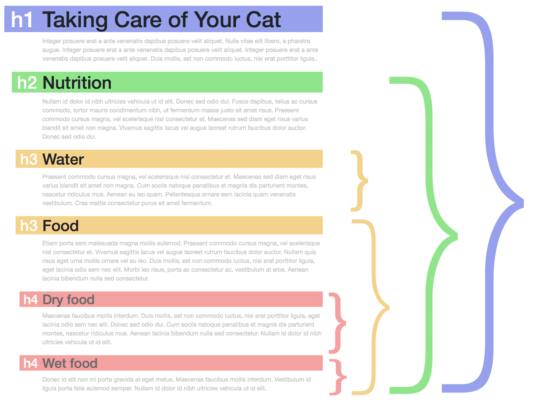We don’t all have the luxury of waiting ‘till a lightning bolt of inspiration strikes to start a blog post. We have content calendars that need filling, after all! It’s not always easy to sit down and write without that creative energy, but creating a good blog post outline will have you churning out quality content regardless.
A blog post outline is a structured roadmap that guides you through your post as you write. Forget about the outlining process you learned in school. We aren’t using any roman numerals here. Our blog post outline strategy is all about creating content that speaks straight to your target audience.
In this post, we’ll show you a blog post outline strategy that will help you create better content in less time. Let’s get started.
Why do you need a blog post outline?
Creating a blog post outline is a way to plan your writing process with intention. It forces you to take a hard look at how the topic relates to your target audience and what they can get out of the post.
When you outline your post before you start writing, you commit to your idea. All the data and subheadings you collect support your main idea, which makes for better quality blog posts. The more your posts answer troubling questions and offer solutions for your readers, the more time they’ll spend on your site. Adding this one step to your writing process can transform the quality and ROI of your blog content.
Plus, creating a blog post outline makes the whole writing process easier, starting with research. You can plug your links right into the sections where they belong and even pull out quotes and statistics and place them where you need them right from the get-go. You won’t have to worry about sifting through your research or revisiting pages to find stats, which is a major time saver.
Having a structured blog post outline also prevents writer’s block. It breaks long, daunting posts into achievable little chunks you can knock out one at a time. You can even use a Pomodoro timer to see how fast you can finish each section. It’s great practice for those who want to write faster.
How to write an awesome blog post outline
Ready to get started? Here are 8 steps to creating an awesome blog post outline:
Step 1: Identify your main idea
Every good blog post starts with a big idea. This is the main idea that ties all of the sections in your blog post together. If you don’t start your blog post with one main idea, you might end up with a disjointed post that confuses the reader.
The main idea becomes your headline. While many blog posts use the target keyword as the main idea, a good blog post outline combines that keyword with a unique angle to create a main idea and headline that will differentiate their blog post from the rest.
Here’s an example of how this process can look:
I was given the keyword “social media strategies” and asked to write a blog post outline.
The company’s audience was mainly employees at small businesses, so I chose to angle the post as a social media strategies guide for small businesses.
This was the final headline/main idea: Social media strategies for small businesses
If your blog post is just a copy of all the others ranking for the keyword, it will be hard to rank. Choosing a good main idea helps you write a unique blog post catered to your target audience that sets you apart from your competition.
Step 2: Think about the purpose of the post
Next, it’s time to consider the purpose of your post. You should know how your post will end and what the readers will take from it from the very beginning of the blog post outline process.
This is where you think hard about who will be reading your post, what you want them to take from it. Figure out what questions you need to answer and what research answering those questions will require. Finally, think about your final call to action (CTA) and how to set the post up so that the CTA offers a solution to the problem addressed in the post.

The last thing your readers want is to clickbait your readers with a headline that the content doesn’t back up. Identifying the path you want your blog post outline to take early on ensures your post will actually achieve the goal set by your main idea.
Step 3: List out what you intend to cover
Now that you have a main idea and know where you want your post to end, it’s time to fill in the gaps with a list of all the topics/questions you intend to cover.
Put yourself in the shoes of your target audience and think about what information they already know, what they probably don’t know, and what will be most helpful to them.
This list could include topics like “What is a social media strategy?” and “Why do you need a social media strategy?”, examples and case studies, relevant statistics, etc.
This step is your brainstorming stage. It acts as a pool of information for you to pick from and organize into subheadings later on.

Step 4: Identify what you already know-- and what you don’t
Now, it’s time to think about what you do and don’t already know. This is your research phase. Look at the questions and topics you listed in Step 3 and jot down any facts and information you already know. After this step, it’s time to fill in the gaps with research.
Step 5: Put your information into sections and give them headings
This is the step where you combine all the information you’ve collected so far into distinct sections. Start by picking out any obvious sections (like “What is a social media strategy”, for example). Make these sections subheadings and gather all the supporting information beneath them. Next, group relevant leftover data into sections and make each section a subheading.

This step will show you how the information you collected actually fits into the structure of your blog post. It can reveal gaps in your research or even data that just doesn’t fit into the post.
Step 6: Order your subheadings
Next, order your subheadings in a way that makes sense. They should flow from a surface-level explanation of the big idea into the sections that answer or solve the problem addressed in the big idea. The purpose of your blog post will play a big role here.
For example, if you’re trying to persuade your audience to try a social media strategy, then you’ll want the topic “Why you need a social media strategy” to be near the top of your post.
Step 7: Refine your headings to fit the angle
Your blog post outline is almost complete! At this point, you’re just refining and perfecting your headings to make sure they fit your angle and provide a solid solution for your reader.
Your refined headings should be attention-grabbing and skimmable. You want your readers to open up the link, skim the headings, and choose to read the post.
Here’s an example:
You might have a subheading titled “Social media platforms”. This is broad.
“Identifying the right social media platforms” is more skimmable because it shows the reader what they’ll be learning about the topic in that section rather than just identifying the broad topic.
The headings need to clearly reflect their contents for this to work. If a reader skims the headings and can’t figure out what the blog post is about, they probably won’t stick around to read it.
Step 8: Start your draft
Finally, you’re ready to start your draft! You’ve created a killer blog post outline with a unique angle that your target audience will love. Following this outline will make your drafting process faster. Once you have the structural work down, there’s less room for error and it’s easier to stay on topic while drafting your post. After using a good blog post outline, you’ll likely breeze through the editing process.
Wrapping up on blog post outlines
Making a blog post outline can transform your writing process. So many writers skip this process because they think it’s unnecessary or a waste of time. In reality, it streamlines the writing process and helps you create informative, persuasive content in less time.
Everyone’s workflow is different. You might benefit from an outline with more details or a simpler outline that just lists subheadings. The best way to figure out what works best for you is to just try both. Start with a detailed outline, then try a simple one. Time your writing to see which process takes less time, but also pay attention to which outline makes the writing process easier and more effective.
The more outlines you make, the more fine-tuned your writing process will be. Happy writing!
